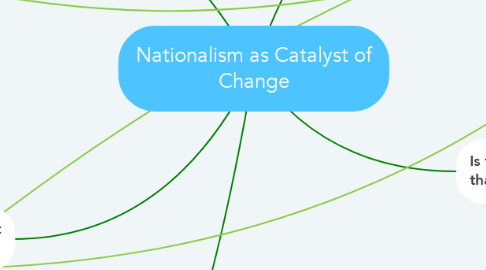
1. Can we avoid the arising of hypernationalism, or is it a natural fact of an international system?
1.1. Kohn
1.1.1. Stressed the crucial role of sovereignty
1.1.1.1. awakening of rights opens the first true area of global history
1.1.1.1.1. The world grew from two blocks to a more pluralistic situation
1.2. Calhoun
1.2.1. Nationalism is too diverse a topic for a single theory
1.2.1.1. Plays a role in the modern discourse of political legitimacy.
1.2.1.2. Distinct traditions and situations
1.3. Hall
1.3.1. 'Empire and Ethnicity'
1.3.1.1. Empire, when faced with indigenous cultures, turned to subjugation, pragmatism, justification, and `time out of mind`
1.3.1.1.1. The pushing of one nation's culture onto another led to two forms of nationalism
1.4. Vincent
1.4.1. The idea of citizenship is a very ambiguous topic
1.4.1.1. Liberal view dominants, yet it is debated by the republican view
1.4.1.1.1. Leads to a civil (Republic) versus civic (Liberal) divide
2. Does the quest for power affect nationalistic movements?
2.1. Hall
2.1.1. Arab nationalism only succeeded during British and French rule, after the fall of the Ottoman Empire.
2.1.1.1. The quest for colonial power in the Middle East by European nations fueled the idea of 'Pan-Arabia'
2.2. Calhoun
2.2.1. While Egyptian nationalism arose around the same time as Turkish nationalism, it had to compete with the more broad Arab nationalism
2.2.2. Common rhetoric but different trajectories
2.2.2.1. some power quests curb or fuel movements
2.2.3. Nationalism grew partly out of challenges to authority or legitimacy
2.2.3.1. The people are capable of bestowing authority, and thus nationalism arose to provide more stable states.
2.3. Hintze
2.3.1. Military mobilization served to enhance internal integration, and promote nationalism through ideological indoctrination
3. How does a nationalistic movement become a violent cause, and can it be avoided?
3.1. Hall
3.1.1. Quebec nationalism v. Tamil nationalism in Sri Lanka
3.1.1.1. Quebec has opportunities, especially for the educated
3.1.1.1.1. There was no benefit of killing off opposition groups
3.1.1.1.2. Canada as a state has allowed Quebec to used political challenges to achieve some goals of the nationalists.
3.1.1.2. There are limited opportunities in Sri Lanka
3.1.1.2.1. Ethno-nationalist grievances: Sinhalese and Tamils blame each other for the economic issues in the country.
3.1.1.2.2. Sri Lanka has become violent because the state is used to empower the Sinhalese, automatically excluding the Tamils
3.1.2. Violent British response to the IRA in the 1960s led to furthered violence
3.1.2.1. The insurgency was fueled by the idea of 'an eye for an eye'
3.2. Calhoun
3.2.1. horrors of ethnic cleansing, especially in Bosnia
3.2.1.1. Advocates for a Greater Serbia would have an easier time doing so without the Bosniaks in the way
3.2.1.1.1. There was a benefit to ridding the area of one group
4. How can we differentiate between nationalism and patriotism?
4.1. Calhoun
4.1.1. Western European countries predominated in the discourse of nationalism, and the model of sovereignty is a western European one.
4.1.1.1. Western patriotism was benign and integrative.
4.1.1.1.1. National identity was understood to be established by legitimate membership in a constituted political state.
4.1.1.2. Eastern European patriotism was populist and emotionally disruptive.
4.1.1.2.1. Some cultural or ethnic criteria was present that was distinct from political citizenship.
4.2. Hayes
4.2.1. Argues that nationalism was some sort of religion, while patriotism was a form of pride that could transfer relatively easily.
4.2.1.1. movement from traditional religion to a secular nationalist `religion` highlighted many nationalist movements, especially those in Eastern Europe.
4.2.1.1.1. The nationalistic movements were built on pre-existing boundaries, of ethnicity, for example.
5. Is the idea of nationalism one that is inherently exclusive?
5.1. Calhoun
5.1.1. In Austria-Hungary, while Austrians and Hungarians were seen as being important people of the state, gypsies and Jews were only seen as nationalities: ethnic identity, but no stake to a state.
5.1.1.1. They had incomparable collective claims
5.1.2. Nationalism has been an overwhelmingly male ideology.
5.1.2.1. Men are treated as potential martyrs, while the women are seen as mainly being their mothers.
5.1.2.2. Emphasis on procreation, thinking of the future of the nation.
5.1.2.2.1. Repression of homosexuality
5.1.2.2.2. Rape was a common crime of Serb nationalists in former Yugoslav republics, in order to rid the populations of Bosniaks, for example.
5.2. Fanon
5.2.1. In French Algeria, women wore the Islamic veil. France sought to unveil them and usher in a sense of `modernity`
5.2.1.1. Seen as an attack on male privilege, traditional culture, female modesty, and Islam as a whole.
5.3. Chatterjee
5.3.1. Indian and Bengali nationalists divided culture into domains, like religion, caste, women and peasants.

